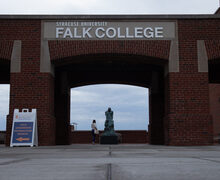Knighton: Retailers should adopt new technology to keep up with times
Holiday shopping amongst a busy crowd can be a pain, but new smart store technology could revolutionize the way we shop.
EBay has partnered with fashion designer Rebecca Minkoff in an attempt to combine the benefits of offline and online shopping. Two Nordstrom locations are set to open this month, fully equipped with interactive dressing rooms and touch screen mirrors.
The ability to physically try on clothes while simultaneously browsing different sizes, styles, colors and even product reviews will change the way future retail stores operate. Enhanced technology in stores is what shopping in the 21st century should look like and other companies should follow Nordstrom’s lead.
This futuristic shopping experience begins with touch screen displays that allow you to look through the store’s items as if you were online. Once you’re done browsing, a sales associate brings your clothes to a fitting room and you are notified by via text when your room is ready. There, you can request a different size to be brought to you, change the lighting in the room and even checkout using PayPal.
This new system is win-win for old-school and new-school shoppers because it doesn’t handicap the people that still prefer to sift through items on the racks. Even if a store doesn’t adopt these high tech dressing rooms, there are still many advantages to having computers accessible for customers.
From a business standpoint, companies benefit from having customer tendencies and purchase history logged in their databases. Store owners could use analytics to suggest matching items and learn customers’ interests for future purchases. Customers would also be able to quickly check if their size is in stock or at different location without flagging down a sales rep.
Self-checkouts in grocery stores were nice a decade ago, but technology has advanced so far since then. It’s time to move forward. One of the retailer’s fears is that older customers may not be so receptive to smart stores, but for many businesses, added technology would fit perfectly, especially in the case of brands with younger audiences such as Forever 21 and H&M. It might be hard for small businesses to absorb such large IT costs but larger companies should jump at the chance of being the trendsetters in merchandising.
Starting this movement with Nordstrom is big. The brand is relatively upscale and extends to a large audience with 118 full-line stores across the U.S. The futuristic vibe meshes well with Nordstrom’s image and it won’t be long before other retailers hop on the bandwagon and adopt a more modern process.
Even with the rise of e-commerce, physical retail will never fully go away so the integration of technology to improve the in-store shopping experience makes sense. This technology is the first real step that blends the convenience of online shopping with the thrill of in-store shopping. Before we know it, high-tech stores will go from the cool new experiment to second nature.
Aarick Knighton is a junior information management and technology major. His column appears weekly. He can be reached at [email protected] and followed on Twitter @aarickurban.
Published on December 4, 2014 at 12:01 am




